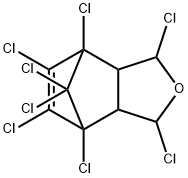Vap press 3 mm Hg (20C). Soluble
in acetone, benzene, carbon tetrachloride, fuel oil,
toluene, xylene.
Isobenzan (telodrin) is a highly toxic organochloride insecticide. It was produced only in the period from 1958 to 1965 and its use has been since discontinued.[1] It is a persistent organic pollutant that can remain in soil for 2 to 7 years, and the biological half-life of isobenzan in human blood is estimated to be about 2.8 years.
ChEBI: Isobenzan is a member of oxolanes.
Crystals. The technical product is a whitish to light-brown crystalline powder with a mild chemical odor. Used as an insecticide. Not registered as a pesticide in the U.S.
Chlorine is evolved when ISOBENZAN is heated above 410F. Avoid acids, certain metal salts, and catalytically active carriers. [EPA, 1998].
ISOBENZAN is highly toxic. It is absorbed by the skin as well as by the respiratory and gastrointestinal tract. Symptoms may last for a long time because the material is eliminated slowly; its half-life in human blood is 2.77 years.
Chlorine is evolved when ISOBENZAN is heated above 410F. Avoid acids, certain metal salts, and catalytically active carriers.
Poison by ingestion, skin contact,intraperitoneal, and intravenous routes. Questionablecarcinogen with experimental tumorigenic data. Used asan insecticide. When heated to decomposition it emitstoxic fumes of Clí.
